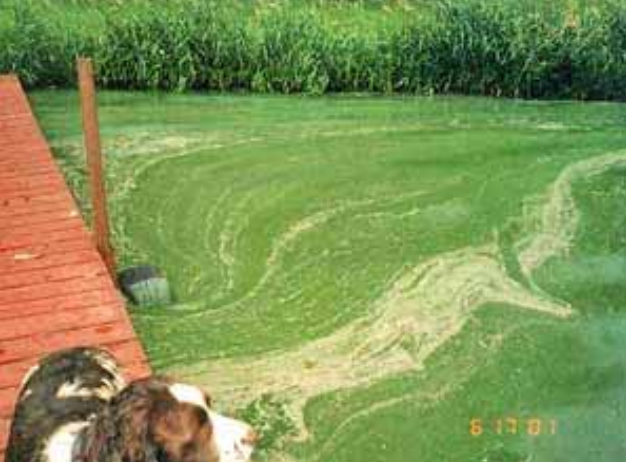
Cyanobacteria is also known as Blue-green Algae, and it can, and has, killed dogs all over the world. Do not take this lightly.
A study published in 2013 found 368 cases of dogs that died or were sickened by BGA in the U.S. between the late 1920s and 2012. The authors say these “likely represent a small fraction of cases” in the U.S. each year. “The vast majority of BGA associated dog deaths remain unreported and often unrecognized by owners and veterinarians.” Eighteen dogs alone have died in Minnesota (Minnesota Pollution Control Agency) in the last ten years, two in 1999 from drinking out of Lake Champlain. In England last month, three dogs died after drinking out of Brooklands Lake in Dartford, Kent.
This microscopic bacteria is found in freshwater lakes, streams, ponds and brackish back waters, and also in unmaintained backyard ponds or where there’s stagnant areas of water – in other words, places where dogs love to romp, jump, wade, and swim. Hunting dogs in particular are predisposed simply because they spend more time outside, and most hunting dogs are purebred dogs. Blue-green algae grows and colonizes to form “blooms” that give the water a blue-green appearance or a “pea soup” like color. Most blue-green blooms aren’t toxic, some blue-green algae produce nerve or liver toxins, and toxicity is hard to predict not only because a single species of algae can have toxic and non-toxic strains, but also because a bloom that tests non-toxic one day can turn toxic the next day.
Treatment is limited and often unsuccessful due to the rapid onset of signs, and prognosis is very poor once those signs have occurred. The signs:
- Vomiting
- Diarrhea
- Blood in stool or black, tarry stool
- Pale mucous membranes
- Jaundice
- Seizures
- Disorientation
- Coma
- Shock
- Excessive secretions (e.g., salivation, lacrimation, etc.)
- Neurologic signs (including muscle tremors, muscle rigidity, paralysis, etc.)
- Blue discoloration of the skin and mucous membranes
- Difficulty breathing
- Death
Learn more about this deadly substance here (a more scientific abstract can be read here). Image from From Minnesota Pollution Control Agency.
